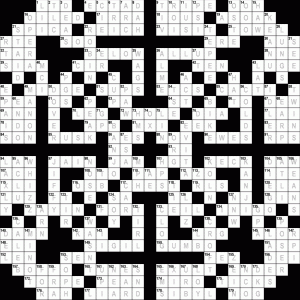Crosswords
I’ve recently started taking the New York Times Crossword Puzzle seriously.
It’s easy to see why people are intimidated by it- the grid can be daunting, a black-and-white menace more reminiscent of the chaotically symmetrical face of an industrial drill bit than a Sunday Breakfast diversion. But with just a small bit of training and a little practice, a wonderfully witty and challenging world unfolds from this mess of clues and letters.
My journey began over coffee, when my friend Eli took the crossword he was working on and scribbled this code above the puzzle:
M – 1
T – 2
W – 3
H – 4
F – 5
S – 6
U – 4
After an inquiry and the admission that I had never completed a full puzzle, Eli elucidated the chart, explaining that it was a difficulty scale for the New York Times Crossword, corresponding to the day of the week. He went on to explain that there are standardized clue conventions, some of which include:
- clues with abbreviations in them have abbreviated answers
- clues that are punctuated with a question mark are always puns
- the long answers are usually related by a common theme
- answers must agree with the clue in terms of tense and part of speech
- clues repeat all the time!
I was encouraged by this new information, and not too long after Eli’s tutorial, I bought a collection of 50 New York Times Monday puzzles. As I tore through them (Monday, it turns out, really IS easy) I found my mind quickly adapting itself to the abstract thinking crosswords encourage. The educational component is huge- I could feel myself beginning to see more connections between concepts, and every puzzle is chock full of interesting things to think about. And like nearly every clever thing made by clever people, there’s plenty of humor involved, as well. Answers to clues are often deliciously witty, and once I even encountered a puzzle with two clues that, when solved, made me laugh out loud. They were: “a Yogi Berra quote” and “a Yogi Berra quote”. This isn’t uncommon, as puzzles often have two identical clues, but they typically have different answers. Not this time.
They were, of course, “ITSDEJAVUALLOVERAGAIN” and, naturally, “ITSDEJAVUALLOVERAGAIN”.
Hilarious.
Try the crossword. It’s fun!

Glad you’ve discovered the joy of crosswords. They can be fun and diverting at the best times – like an extremely turbulent flight? Great time to bust one out.